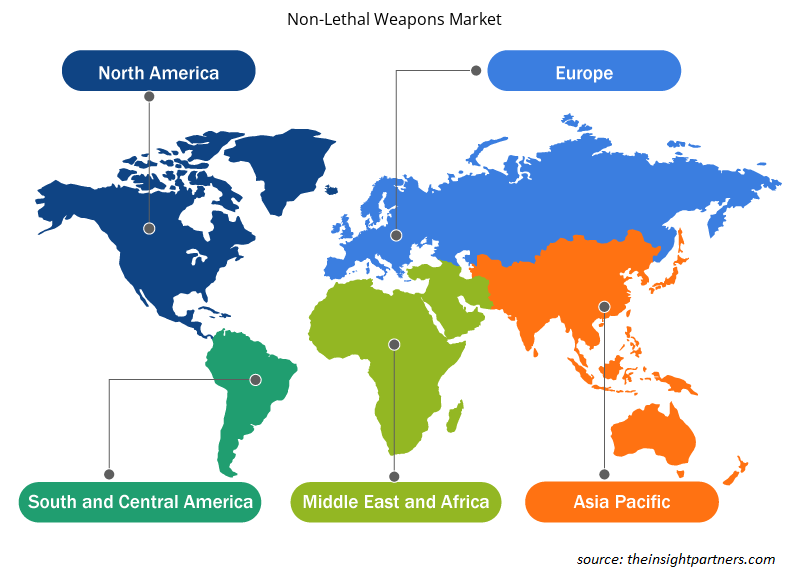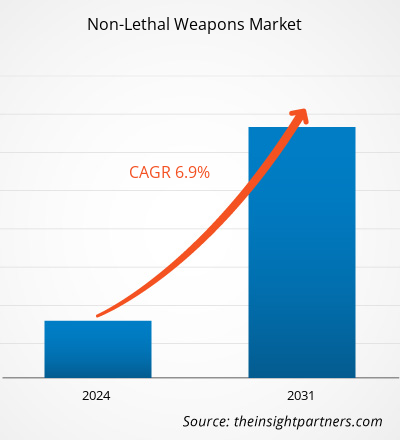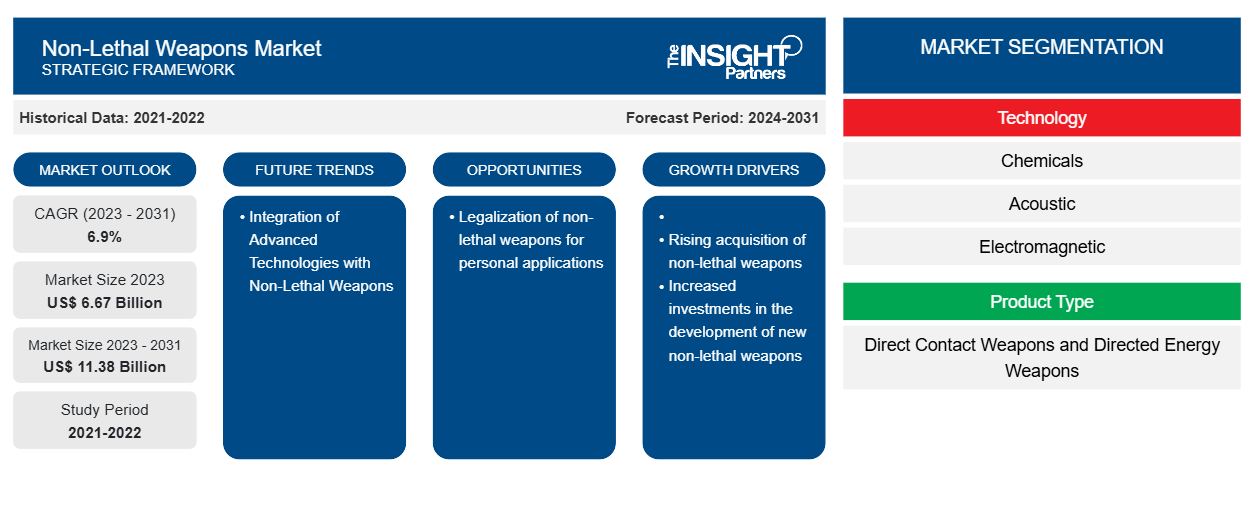Der Markt für nichttödliche Waffen soll von 6,67 Milliarden US-Dollar im Jahr 2023 auf 11,38 Milliarden US-Dollar im Jahr 2031 anwachsen. Für den Zeitraum 2023–2031 wird ein durchschnittliches jährliches Wachstum von 6,9 % erwartet. Die Integration fortschrittlicher Technologien in nichttödliche Waffen dürfte ein wichtiger Trend auf dem Markt bleiben.
Marktanalyse für nichttödliche Waffen
Geringe Produktdifferenzierung für bestimmte Produktkategorien wie Taser, Schlagstöcke und Pfeffersprays, die zu den am häufigsten verwendeten nichttödlichen Waffen unter den Endverbrauchern gehören. Darüber hinaus haben strenge Vorschriften für den Einsatz nichttödlicher Waffen für zivile Zwecke unter bestimmten Umständen auch zu einer Zurückhaltung bei den Privatnutzern geführt. Solche Faktoren haben den Markt in mehreren Segmenten beeinflusst.
Marktübersicht für nichttödliche Waffen
Zunehmende soziale Unruhen und die Militarisierung der Strafverfolgungsbehörden sind die Hauptfaktoren, die das Wachstum des Marktes für nichttödliche Waffen unterstützen. Strenge Umwelt- und Regierungsvorschriften in einigen Entwicklungsländern schränken jedoch das Wachstum des Marktes für nichttödliche Waffen ein.
Darüber hinaus treiben die steigenden Kriminalitätsraten und Aufstände in mehreren Ländern wie den USA, Israel und anderen Ländern die Entwicklung des Marktes für nichttödliche Waffen in verschiedenen Regionen voran.
Passen Sie diesen Bericht Ihren Anforderungen an
Sie erhalten kostenlose Anpassungen an jedem Bericht, einschließlich Teilen dieses Berichts oder einer Analyse auf Länderebene, eines Excel-Datenpakets sowie tolle Angebote und Rabatte für Start-ups und Universitäten.
-
Holen Sie sich die wichtigsten Markttrends aus diesem Bericht.Dieses KOSTENLOSE Beispiel umfasst eine Datenanalyse von Markttrends bis hin zu Schätzungen und Prognosen.
Treiber und Chancen auf dem Markt für nichttödliche Waffen
Erhöhte Investitionen in die Entwicklung neuer nichttödlicher Waffen
Die zunehmende Instabilität in verschiedenen Regionen aufgrund verschiedener umstrittener Gesetze und Vorschriften, die von mehreren Regierungen erlassen wurden, hat den Bedarf an Waffen mit einem geringen Risiko von Opfern erhöht. Menschenrechtsgesetzgeber und Regierungen haben Vorschriften erlassen, die mehrere Sicherheits- und Verteidigungsorganisationen dazu verpflichten, Waffen zu erwerben, die ein geringeres Risiko darstellen, einen Verdächtigen zu töten. Dieser Anstieg der Nachfrage nach weniger tödlichen Waffen hat die Entwicklung neuer und fortschrittlicher nichttödlicher Waffen gefördert. Einige große Akteure auf dem globalen Markt für nichttödliche Waffen sind FN HERSTAL, Lamperd Less Lethal, Combined Systems, Inc., Pepperball und Rheinmetall AG.
Integration fortschrittlicher Technologien in nichttödliche Waffen
Nichttödliche Waffen erfreuen sich aufgrund ihrer fortschrittlichen Funktionen und ihrer Fähigkeit, Unruhen zu beruhigen, ohne Opfer zu fordern, zunehmender Beliebtheit. Rüstungsunternehmen und wichtige Marktteilnehmer haben ihre Produktportfolios mit fortschrittlichen Technologien erweitert, darunter Laser-Abwehrsysteme, akustische Langstreckengeräte, verbesserte Unterwasser-Megaphone, Blendgranaten, akustische Megaphone, modulare Waffen zur Kontrolle von Menschenmengen und Taser . Diese Technologieintegrationen in nichttödliche Waffen treiben das Wachstum des Marktes für nichttödliche Waffen voran.
Segmentierungsanalyse des Marktberichts zu nichttödlichen Waffen
Schlüsselsegmente, die zur Ableitung der Marktanalyse für nichttödliche Waffen beigetragen haben, sind Technologie, Produkttyp und Anwendung.
- Basierend auf der Technologie ist der Markt für nichttödliche Waffen in chemische, akustische, elektromagnetische sowie mechanische und kinetische Waffen unterteilt. Das mechanische und kinetische Segment hatte im Jahr 2023 einen größeren Marktanteil.
- Basierend auf dem Produkttyp ist der Markt für nichttödliche Waffen in Direktkontaktwaffen und Energiewaffen unterteilt. Das Segment der Direktkontaktwaffen hatte im Jahr 2023 einen größeren Marktanteil.
- Nach Anwendung ist der Markt in Strafverfolgungsbehörden , Militär und personalisierte Anwendungen unterteilt. Die Strafverfolgungsbehörden hielten im Jahr 2023 den größten Marktanteil.
Nichttödliche Waffen – Marktanteilsanalyse nach geografischer Lage
Der geografische Umfang des Marktberichts für nichttödliche Waffen ist hauptsächlich in fünf Regionen unterteilt: Nordamerika, Europa, Asien-Pazifik, Naher Osten und Afrika sowie Südamerika.
Nordamerika dominierte den Markt im Jahr 2023, gefolgt von Europa und dem asiatisch-pazifischen Raum. Darüber hinaus dürfte der asiatisch-pazifische Raum in den kommenden Jahren die höchste durchschnittliche jährliche Wachstumsrate verzeichnen. Die steigenden Investitionen regionaler Akteure in die Entwicklung fortschrittlicher nichttödlicher Waffen dürften ebenfalls das Wachstum des Marktes für nichttödliche Waffen vorantreiben. So entwickelte beispielsweise ein in Uttar Pradesh ansässiges indisches Unternehmen nichttödliche Waffen wie Varja und Trishul, um seine Streitkräfte nach dem Zusammenstoß im Galwan-Tal vor plötzlichen Angriffen zu schützen. Somit kurbeln diese oben genannten Faktoren das Wachstum des Marktes für nichttödliche Waffen im asiatisch-pazifischen Raum an.
Regionale Einblicke in den Markt für nichttödliche Waffen
Die regionalen Trends und Faktoren, die den Markt für nichttödliche Waffen im Prognosezeitraum beeinflussen, wurden von den Analysten von Insight Partners ausführlich erläutert. In diesem Abschnitt werden auch Marktsegmente und Geografie für nichttödliche Waffen in Nordamerika, Europa, im asiatisch-pazifischen Raum, im Nahen Osten und Afrika sowie in Süd- und Mittelamerika erörtert.

- Erhalten Sie regionale Daten zum Markt für nichttödliche Waffen
Umfang des Marktberichts zu nichttödlichen Waffen
| Berichtsattribut | Details |
|---|---|
| Marktgröße im Jahr 2023 | 6,67 Milliarden US-Dollar |
| Marktgröße bis 2031 | 11,38 Milliarden US-Dollar |
| Globale CAGR (2023 - 2031) | 6,9 % |
| Historische Daten | 2021-2022 |
| Prognosezeitraum | 2024–2031 |
| Abgedeckte Segmente |
Nach Technologie
|
| Abgedeckte Regionen und Länder |
Nordamerika
|
| Marktführer und wichtige Unternehmensprofile |
|
Marktteilnehmerdichte für nichttödliche Waffen: Auswirkungen auf die Geschäftsdynamik verstehen
Der Markt für nichttödliche Waffen wächst rasant, angetrieben von der steigenden Nachfrage der Endnutzer aufgrund von Faktoren wie sich entwickelnden Verbraucherpräferenzen, technologischen Fortschritten und einem größeren Bewusstsein für die Vorteile des Produkts. Mit der steigenden Nachfrage erweitern Unternehmen ihr Angebot, entwickeln Innovationen, um die Bedürfnisse der Verbraucher zu erfüllen, und nutzen neue Trends, was das Marktwachstum weiter ankurbelt.
Die Marktteilnehmerdichte bezieht sich auf die Verteilung der Firmen oder Unternehmen, die in einem bestimmten Markt oder einer bestimmten Branche tätig sind. Sie gibt an, wie viele Wettbewerber (Marktteilnehmer) in einem bestimmten Marktraum im Verhältnis zu seiner Größe oder seinem gesamten Marktwert präsent sind.
Die wichtigsten auf dem Markt für nichttödliche Waffen tätigen Unternehmen sind:
- BAE Systems
- Kombinierte Systeme, Inc.
- Nichttödliche Technologien von Condor
- FN Herstal
- Lamperd, Inc.
Haftungsausschluss : Die oben aufgeführten Unternehmen sind nicht in einer bestimmten Reihenfolge aufgeführt.

- Überblick über die wichtigsten Akteure auf dem Markt für nichttödliche Waffen
Nachrichten und aktuelle Entwicklungen zum Markt für nichttödliche Waffen
Der Markt für nichttödliche Waffen wird durch die Erhebung qualitativer und quantitativer Daten aus Primär- und Sekundärforschung bewertet, die wichtige Unternehmensveröffentlichungen, Verbandsdaten und Datenbanken einschließen. Nachfolgend sind einige der Entwicklungen auf dem Markt für nichttödliche Waffen aufgeführt:
PepperBall, der führende Anbieter innovativer nichttödlicher Lösungen für die Strafverfolgung, ist stolz darauf, die Einführung seiner neu gestalteten TAC-SA-Modelle – TAC-SA PRO und TAC-SA PRO PLUS – auf der diesjährigen SHOT Show am Stand 72205 bekannt zu geben. Diese Werfer repräsentieren die neuesten Fortschritte bei nichttödlichen Reaktionslösungen und sind auf die vielfältigen Bedürfnisse von Strafverfolgungsfachleuten zugeschnitten. (Quelle: PepperBall, Pressemitteilung, Januar 2024)
- PepperBall, ein führender Anbieter nichttödlicher Lösungen für die Strafverfolgung, ist stolz darauf, die Einführung seiner neu gestalteten Werfer FTC PRO und FTC PRO PLUS bekannt zu geben. Diese hochmodernen Modelle werden auf der SHOT Show 2024 vorgestellt. FTC PRO und FTC PRO PLUS sind so konzipiert, dass sie den sich ständig weiterentwickelnden Anforderungen von Strafverfolgungsbeamten gerecht werden. Obwohl beide Werfer eine Reihe innovativer Funktionen gemeinsam haben, verfügt jeder über einzigartige Aspekte, die auf spezifische betriebliche Anforderungen zugeschnitten sind. (Quelle: Lockheed Martin Australia, Pressemitteilung, Januar 2024)
Marktbericht zu nichttödlichen Waffen – Abdeckung und Ergebnisse
Der Bericht „Marktgröße und Prognose für nichttödliche Waffen (2021–2031)“ bietet eine detaillierte Analyse des Marktes, die die folgenden Bereiche abdeckt:
- Marktgröße und Prognose für nichttödliche Waffen auf globaler, regionaler und Länderebene für alle wichtigen Marktsegmente, die im Rahmen des Berichts abgedeckt sind
- Markttrends für nichttödliche Waffen sowie Marktdynamiken wie Treiber, Beschränkungen und wichtige Chancen
- Detaillierte Porter-Fünf-Kräfte-Analyse
- Marktanalyse für nichttödliche Waffen, die wichtige Markttrends, globale und regionale Rahmenbedingungen, wichtige Akteure, Vorschriften und aktuelle Marktentwicklungen umfasst
- Branchenlandschaft und Wettbewerbsanalyse, die die Marktkonzentration, Heatmap-Analyse, prominente Akteure und aktuelle Entwicklungen auf dem Markt für nichttödliche Waffen umfasst
- Detaillierte Firmenprofile
- Historische Analyse (2 Jahre), Basisjahr, Prognose (7 Jahre) mit CAGR
- PEST- und SWOT-Analyse
- Marktgröße Wert/Volumen – Global, Regional, Land
- Branchen- und Wettbewerbslandschaft
- Excel-Datensatz
Aktuelle Berichte
Erfahrungsberichte
Grund zum Kauf
- Fundierte Entscheidungsfindung
- Marktdynamik verstehen
- Wettbewerbsanalyse
- Kundeneinblicke
- Marktprognosen
- Risikominimierung
- Strategische Planung
- Investitionsbegründung
- Identifizierung neuer Märkte
- Verbesserung von Marketingstrategien
- Steigerung der Betriebseffizienz
- Anpassung an regulatorische Trends























 Kostenlose Probe anfordern für - Markt für nichttödliche Waffen
Kostenlose Probe anfordern für - Markt für nichttödliche Waffen